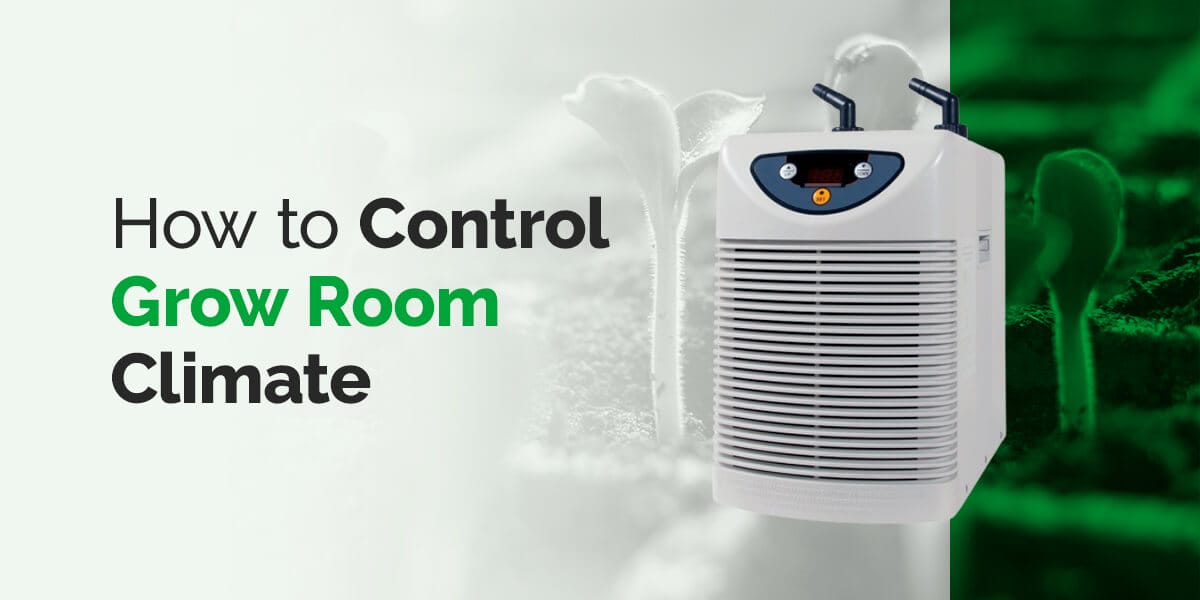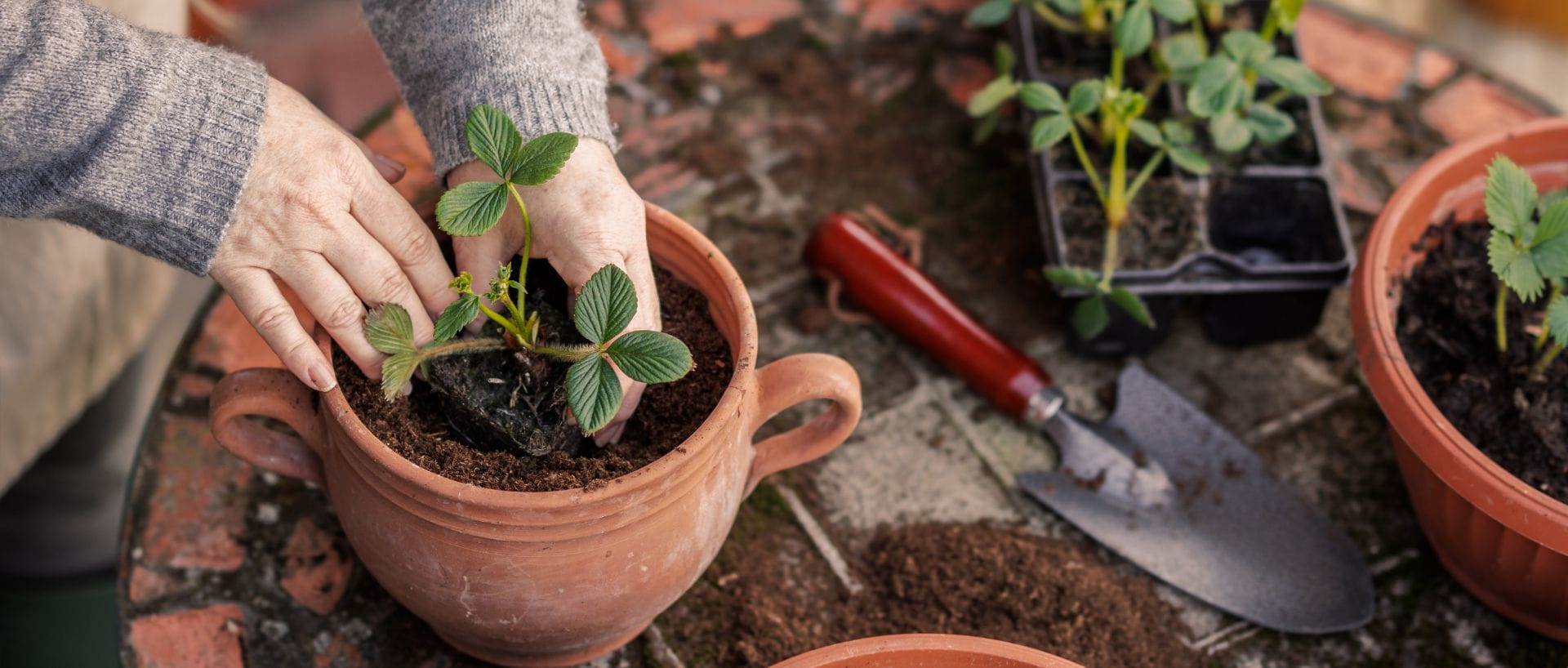By: HTG Supply on 10/27/2017
This week, we’re going to keep it breezy – let’s talk about grow room airflow!
In the great outdoors, sunlight, rain and groundwater, helpful insects, animals, and atmospheric conditions are all forces that factor into healthy plant growth and development. But when we grow plants indoors, we have to manually compensate for those circumstances as best we can. While watering your plants and providing them with light is pretty obvious, most people don’t think much about the wind until it blows – but your plants certainly do. In this week’s Talking Shop, we’ll cover the effects of air movement through and within the grow room including its impact key growth factors like CO2 levels and vapor pressure deficit. We’ll also show you how to calculate your CFM requirements. Plus, be sure to read through for the featured product promo code and our deals of the week!
Ventilation & Circulation in the Grow Space
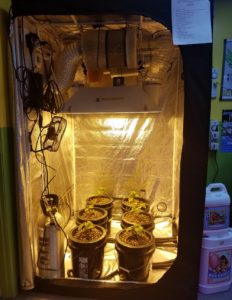
Ventilation/circulation setup for a grow tent from HTG Cranberry, which includes a fan/filter exhaust and simple 9″ fan for air movement.
Without air circulation to replicate the wind that occurs naturally outdoors, your plants will grow spindly and weak. In nature, wind forces a plant’s fibers to strengthen themselves during growth in order to keep from bending or breaking in the breeze. Those stronger fibers result in the whole plant growing bigger and stronger, which means better yields and prolonged growth. If you don’t allow your plants to be ‘tested’ by any kind of wind, they may not even be able to support the weight of their own fruits and they certainly won’t grow well either way.
Furthermore, did you know that plants have to ‘breathe’ for photosynthesis to occur? On the underside of a plant’s leaves you’ll find what are called stomata. Stomata are like tiny little nostrils that inhale carbon dioxide (C02) and exhale oxygen. When you use inline fans or high-velocity fans to introduce fresh air to your garden, you are introducing fresh C02 for the plants to ‘inhale’. And when you use air circulation fans to move that fresh air across the plant’s leaves, you are creating an environment more aligned with what a plant would experience outside in the natural habitat it has evolved to thrive in.
Air Circulation with CO2
Proper air circulation within the grow space plays a critical role in any situation involving CO2 enrichment. CO2 is heavier than oxygen, so you have to make sure that the air in your tent is moving enough to keep that CO2 from just settling at the floor. Fortunately, we ARE still talking about air here, so that’s not a difficult task – a couple small fans in the corners (or one oscillating fan lazily sweeping back and forth) will be plenty for most small setups. Basically, if you can see your plant’s leaves moving a little bit in the breeze, you’re nailing it.
Speaking of enrichment, plants have evolved to be able to utilize much higher levels of CO2 than what our natural atmosphere provides today, and when levels of CO2 are increased in your garden plants will respond by raising their metabolic activity – creating more sugars, energizing growth, and increasing overall yield size by up to 30%. Ambient Co2 levels range from 300-500 ppm (parts per million), but your plants can use up to around 1200-1500 ppm! This is a great reason to consider a sealed grow room if you haven’t already. A sealed grow area will allow you to personally control the CO2 levels in your garden and optimize the whole space for your plants. Many gardeners use their tank and CO2 tank regulator or a CO2 generator to enhance their CO2 levels only during the light cycles, then exhaust their air during their night cycle (thus reducing the cost of their CO2 enrichment process). But if you have a smaller setup like a 4×4 tent, you can get away with an Exhale bag that will last 9 months for only $35 bucks.
Temperature & Humidity Control
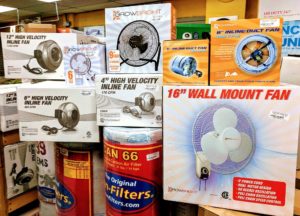
We’re not done yet! Air circulation doesn’t JUST help your plant grow stronger and redistribute CO2 across it, no, it does much more than that. The airflow in your garden affects the temperature and humidity too. On a hot summer day, you enjoy a healthy breeze from a fan, right? You might even open a window to let some fresh air in. Well, your plants need that same consideration.
Plants “sweat” just like people do, except they do it all the time. This is called transpiration and it’s a big part of your plants’ health. You already know that plants suck up nutrients and water from the soil, but all that water can’t possibly stay in the plant; instead, moisture is constantly being evaporated out of the plant’s leaves, flowers, and stems. All that moisture doesn’t just disappear, either – anyone who’s ever been inside a greenhouse knows that! The air around plants can become extremely humid if your plant is transpiring at a healthy rate, but since your plants aren’t outside, all that humidity doesn’t just go up into the sky or blow away on the wind. Instead, it stays all around your plant. Generally, it’s not good to keep your plants in an environment where the air is wet because of things like powdery mildew, leaf spots, and botrytis (or bud rot). Also, a very humid environment will make your soil take much longer to dry out, which can lead to a weak or “lazy” root zone. Finally, humid environments are perfect nesting grounds for pests like gnats or mites that will wreck your plants.
All those problems can be avoided by keeping your humidity in check, which is an easy task with proper air circulation and ventilation. Most plants grow well in temperatures of around 75°F to 79°F (26°C to 29°C); if the temperature gets higher than this, the rates of photosynthesis will begin to decrease. Humidity differs a lot more, though. Clones (ones without an established root zone) prefer a high humidity of 70-80%, which is why we offer enclosed seed starting and cloning kits designed to provide just that environment. Plants in their vegetative growth phase need less than that, though, thriving in the 40-70% range (50-55% is considered optimal). And flowering plants should be kept in the lower 40-50% range in order to avoid bud rot. That all said, remember that your plants can’t handle an atmosphere that’s too dry, either. If the humidity is too low, the stomata will close tighter in an effort to retain what moisture they already have. This slows down feeding which will result in a small, malnourished plant that could dry out and die entirely. Consider adding a temperature and humidity controller to your ventilation system if it’s in your budget. These controllers activate ventilation based on actual monitored temperature and humidity levels.
HEAT & VAPOR PRESSURE DEFICIT
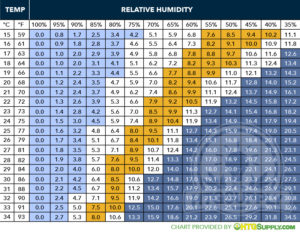
Plants can also stress if temperatures are too high in your grow room or grow tent. Hotter air holds more moisture because the molecules in the air are energized by the heat, causing them to move around faster and expand, making room for more molecules to enter the air. Plants will, in turn, transpire quickly to balance the VPD (vapor pressure deficit), leaving them unable to replenish the water and nutrients at the rate at which they’re being lost. High heat and VPD imbalances can also lead to hermaphrodites and lower yields, as well as problems in hydroponic systems and difficulty controlling odors. Notice the relationship of temperature and humidity as it relates to the VPD in the chart shown here.
Indoor Garden Air Circulation Setup
There are several tools which make it a breeze to monitor and control your humidity and temperature, but the gadgets are only as helpful as the actual sense behind the setup. A fan doesn’t do any good if it’s not pointed at something, right? That’s a fairly silly example, but it illustrates a point: your setup has to be, well, set up. You’ll get decent results if you do a decent job, but to get excellent results you have to think it out. For example, let’s say you need to ventilate the excess humid air from your tent. Opening your vents is a solution, but it’s not the best one. What you really need in this situation is an exhaust system, which is much less expensive or intimidating than it sounds. A simple duct fan is all you really need for smaller spaces like a tent – just put it right in your tent’s vent port (preferably one that’s higher up) and you’re set, it’ll suck unwanted air out of your tent and as long as you leave an open vent on the other side, fresh air will replace it. If you do it this way, just be aware that the open vent should be covered with a filter of some sort to prevent pests and mold from coming in with the fresh air.
If you’re feeling inspired, you can employ a slightly more advanced setup using a second duct fan. In this case, you’ll place the first fan in a higher-up position, either on top or high on the wall. Since hot air rises, this will efficiently pull the hottest air out of the tent. Then you’ll place your second fan in a vent near the floor of the tent, pulling air IN. Most tents can get by with just a 4″ duct fan for this purpose. With this system, fresh air will be sucked into the tent at the bottom and exit at the top, and it’ll collect moisture from the plant and spread CO2 the whole way up. We recommend having a slightly bigger and/or stronger fan blowing OUT than sucking IN, though, just to be safe. This helps to create a negative pressure inside of the space, which helps to maintain proper airflow.
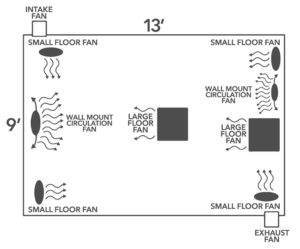
Will from Commerce City says: “In a 9’ x 13’ room, I would have about 10 fans in total. This includes an intake, exhaust, floor, and circulating/wall-mount fans. I made a diagram to show you what I mean – don’t judge my drawing skills!” (We totally judged his drawing skills and remade the picture, sorry Will!)
How to Calculate CFM Requirements
There’s a pretty simple formula to figure out how strong your fan needs to be to optimally circulate your air. We’ll take the width x length x height. (Example: a tent or room that is 12f x 10f x 8f = 960 cubic feet.) Now you need to decide how often you want to exchange the air the room. For this example, we’ll use 4-minute intervals. Dividing the cubic feet (960) by the number of minutes (4) will provide the Cubic Feet Per Minute, or CFM – in this case, 240. So we’re looking for an outtake fan (or a combination of outtake fans) that’s around 240, or even very slightly higher. But wait, hang on, there’s one last factor: our lighting. LED grow lights don’t really contribute to the heat of the tent/room in any substantial way, but if we’re using lights that heat up (like CMH or HPS lights), we’ll need to account for the extra heat they cause. In that situation, we just add 10% to our total for every 1000w of lighting. So if we have four 1000w lights, we add 40%, which brings our total up to 336. Don’t worry, all our duct fans are specifically labeled with their CFM information and if you’re ever not sure about anything, just ask us! Also, it’s important to know that the strength of the fans increases exponentially with their size; the 4-inch GrowBright HV fan is rated at 170 CFM, but the only slightly larger 6-inch unit is more than twice as powerful at 400 CFM (and it’s only about $25 more). If you can’t find a model that offers a CFM directly in line with your calculations, you can always grab a larger fan and use it with a fan speed controller to dial in the optimal airflow. So if you’re doing the math and worrying about how many fans it’ll take to handle the big numbers you’re coming up with, worry no more – chances are, it’s MUCH cheaper and simpler than you think.

Even in a sealed space, we recommend a full air exchange at least twice a day or up to every four hours if a CO2 generating burner is being used, because combustion leads to ethylene buildup. Ethylene buildup can become an issue even before you can visually see the problem because it stunts plant growth, but advanced symptoms will manifest in wilted-looking leaves that have retained their turgidity (water pressure inside the plant). You should swap out air more often in smaller spaces, of course, but people sometimes assume that a large enough room negates the need for ventilation. If you don’t properly supply your plants with the air they need, they won’t grow to their potential.
FACTORING FILTERS INTO YOUR CFM CALCULATIONS
For those of you with more advanced needs, another consideration to account for will be air filtration. We touched on it briefly earlier, but if you have a big/complicated setup and you want to be sure that your plants are protected, HEPA intake filters are the way to go. GrowBright HEPA filters catch 99.97% of airborne particles 3 micrometers or smaller in size, and all you have to do is slip one over your intake fan/port. For further protection (and for odor control purposes), an activated carbon filter for your outtake fan will do wonders. Same principle, just connect it directly to the duct fan that’s blowing air out of your tent and you’re set! Using these filter types is a best practice for indoor growing, but they will lower the airflow rate of their partner fans in the ventilation system. Be sure to factor this into your calculations if applicable to ensure proper air movement is maintained.
_____________________
We hope we’ve given you something to think about – your air circulation and quality should be just as carefully planned as your lighting and nutrition to ensure a bountiful harvest! Be sure to see below for this weeks coupon code and sale information! As always, drop by your local HTG Supply store if you have any questions, and don’t forget to follow us on social media to be notified whenever we post more articles just like this one (and whenever we have our awesome sales). From all of us here, good luck, stay safe, and Happy Growing!
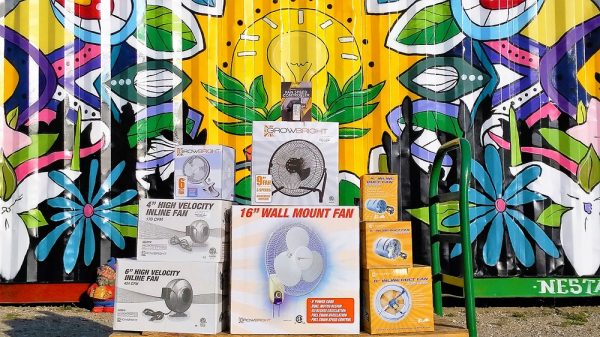
THIS WEEK’S COUPON CODE: AIRFLOW1017
Enter this week’s promo code at checkout for a 10% discount on the featured products shown below, or visit your local store and simply mention this article to get the deal! Thanks again for tuning into Talking Shop with HTG Supply!
